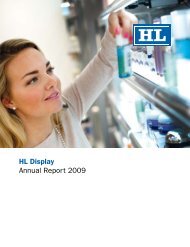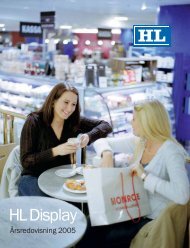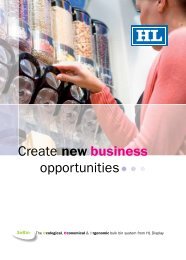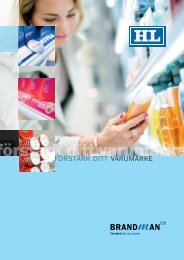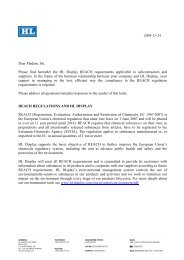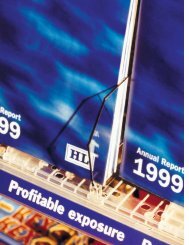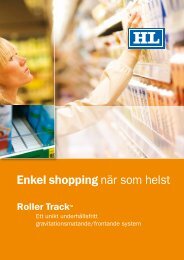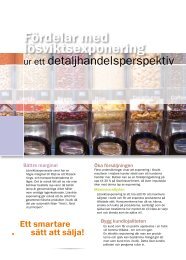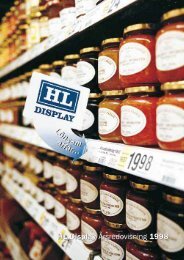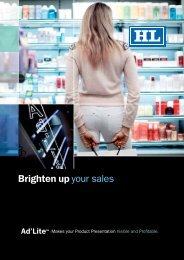Annual Report 2004 - HL Display
Annual Report 2004 - HL Display
Annual Report 2004 - HL Display
Create successful ePaper yourself
Turn your PDF publications into a flip-book with our unique Google optimized e-Paper software.
<strong>HL</strong> <strong>Display</strong>’s new Slimline shelf-edge strip can be adapted to carry electronic<br />
price labels from all of the major manufacturers.<br />
many years, resulting in significant efficiency gains.<br />
Efforts are being made within <strong>HL</strong> <strong>Display</strong> to make business intelligence<br />
information quickly accessible as a foundation for decision-making.<br />
During the year system support was also extended to<br />
include a forecast module and a customer project module.<br />
The forecast module replaces the budget model previously used<br />
by <strong>HL</strong> <strong>Display</strong>, and the aim is to achieve increased quality in cost<br />
and revenue planning. The system also offers support for early<br />
warnings, i.e. potential problem areas are identified at an early<br />
stage and can thus be rectified before they cause major problems.<br />
The customer project module provides support for <strong>HL</strong> <strong>Display</strong>’s<br />
sales organisation in its work on major customer projects. The<br />
aim is to provide a simple tool that helps the sales organisation<br />
gain better control over all activities included in large, complex<br />
customer projects. The module is also an element of <strong>HL</strong> <strong>Display</strong>’s<br />
work to improve the quality and secure the information in the sales<br />
process.<br />
The environment<br />
<strong>HL</strong> <strong>Display</strong> has an ongoing environmental programme, based on<br />
the company’s environmental policy. This work takes place at each<br />
production site, under the guidance of an Environment and Quality<br />
Manager, who is responsible for developing plans, implementing<br />
projects and following up and reporting on action taken in the environmental<br />
field. Only one of <strong>HL</strong> <strong>Display</strong>’s factories has activities<br />
that involve an obligation to register, relating to the use of solvents<br />
in screen-printing. There are no production facilities that require<br />
permits under the Environmental Code.<br />
Environmental certification is an important external assessment<br />
of <strong>HL</strong> <strong>Display</strong>’s environmental work. It is the company’s objective<br />
that all production facilities shall undergo the environmental audit<br />
9<br />
STRUKTURER & ARBETSSÄTT<br />
<strong>HL</strong> <strong>Display</strong>’s segmentation strip enables stores to add information alongside<br />
products to make life easier for the consumer.<br />
and certification in accordance with the international standard for<br />
environmental management systems, ISO 14001. <strong>HL</strong> <strong>Display</strong>’s<br />
two largest production facilities, Falun and Sundsvall, are already<br />
certified in accordance with this standard. During the year the factory<br />
in Karlskoga also underwent an environmental audit and was<br />
certified in accordance with ISO 14001.<br />
Most of <strong>HL</strong> <strong>Display</strong>’s environmental impact is caused by PVC<br />
waste from production. In <strong>2004</strong> <strong>HL</strong> <strong>Display</strong> generated 892 tonnes<br />
of PVC waste in production, of which 700 tonnes were sent to<br />
recycling. In relative terms this is an increase in recycled PVC of<br />
7.7 per cent. The PVC used by <strong>HL</strong> <strong>Display</strong> is free of phthalates and<br />
through a collaboration with the main supplier of raw materials,<br />
<strong>HL</strong> <strong>Display</strong> attempts to increase the degree of recycled material in<br />
the PVC that is purchased.<br />
At present the company can manufacture all products in alternative<br />
materials. This is a core element of the investments being<br />
made in machinery, as machines must be able to manufacture<br />
using several materials.<br />
UV paint is increasingly being used for screen-printing at the<br />
factory in Falun, instead of the traditional solvent-based paint. In<br />
contrast to regular paint, UV paint does not dry through the evaporation<br />
of solvents, but by means of UV radiation in a so-called UV<br />
drier. 34.7 per cent of all screen-printing now uses UV paint.<br />
During the year <strong>HL</strong> <strong>Display</strong> implemented energy-saving measures<br />
at some of its production facilities. A closed cooling system has<br />
been implemented in the machines in the Karlskoga factory, and<br />
<strong>HL</strong> <strong>Display</strong>’s biggest production facility, Sundsvall, is being heated<br />
with waste heat from the machines.<br />
<strong>HL</strong> DISPLAY ANNUAL REPORT <strong>2004</strong>




